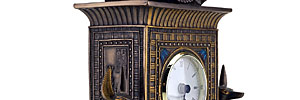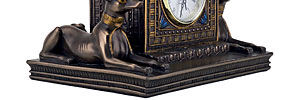Isis was the Egyptian goddess of Magic and Life - the patron saint of mothers, women, and children. She was also known as the goddess of healing. Her name literally means 'Queen of the Throne', which was portrayed by the throne emblem on her head. The hieroglyph of her name meant 'she of flesh' (or mortal) originally, and she may have represented historical queens and female deities. Ancient Egyptians believed that Isis's tears of sorrow for her dead husband Osiris caused the Nile River to flood every year. Osiris was killed by Isis's evil brother, Set, the god of destruction and chaos. It was believed that Set chopped Osiris into pieces and threw them into the Nile River, letting the animals consume his remains. All of the pieces are said to have survived, except for one.

Anubis, in the original Ogdoad system, was known as god of the underworld. He was believed to have a wife (Anput) who was depicted in the same image, but feminine. He is also believed to have taken to wife Nehebka (the feminine form of Neheb Kau), and Kebauet (the Goddess of Cold Water). He was thought to be the fourth son of Ra, who was depicted as his father in many papyrus records found in Egyptian pyramids. In later times, his father was said to be Osiris, as he was god of the dead, and his mother was believed to be Nephthys. His daughter, Kebechet, was the goddess of the purification of body organs due to be placed in canopic jars during mummification.
Cold Cast is a modern method of casting sculptures using a mixture of resin and powdered polymer materials. The finished sculpture has a surface which looks very similar to traditionally cast material, but tends to be much lighter.


















